1999 HONDA CIVIC COUPE spare tire
[x] Cancel search: spare tirePage 194 of 269

Tires
To safely operate your car, your tires must be the proper type and size, in
good condition with adequate tread, and correctly inflated. The following
pages give more detailed information on how and when to check air
pressure, how to inspect your tires
for damage and wear, and what to do
when your tires need to be replaced.
Inflation
Keeping the tires properly inflated
provides the best combination of
handling, tread life and riding comfort. Underinflated tires wear
unevenly, adversely affect handling and fuel economy, and are more
likely to fail from being overheated. Overinflated tires can make your car
ride more harshly, are more prone to damage from road hazards, and wear
unevenly.
We recommend that you visually check your tires every day. If you
think a tire might be low, check it immediately with a tire gauge. Use a gauge to measure the air
pressure at least once a month. Even
tires that are in good condition may
lose one to two psi (10 to 20 kPa, 0.1
to 0.2 kgf/cm2) per month. Remember to check the spare tire at
the same time you check all the other tires.
Check the pressure in the tires when
they are cold. This means the car has been parked for at least three
hours. If you have to drive the car
before checking the tire pressure, the tires can still be considered
"cold" if you drive less than 1 mile (1.6 km).
CONTINUED
Maintenance
Using tires that are excessively
worn or improperly inflated can
cause a crash in which you can
be seriously hurt or killed.
Follow all instructions in this
owner's manual regarding tire
inflation and maintenance.Main Menu Table of Contents s t
Page 195 of 269
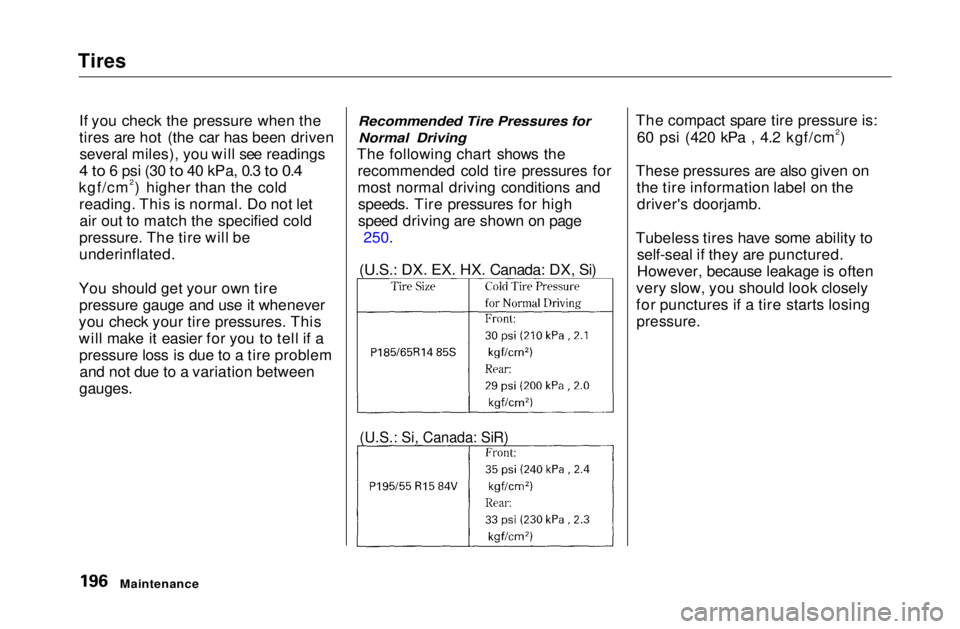
Tires
If you check the pressure when the
tires are hot (the car has been drivenseveral miles), you will see readings
4 to
6 psi (30
to
40 kPa, 0.3
to 0.4
kgf/cm2) higher than the cold reading. This is normal. Do not letair out to match the specified cold
pressure. The tire will be
underinflated.
You should get your own tire pressure gauge and use it whenever
you check your tire pressures. This
will make it easier for you to tell if a pressure loss is due to a tire problemand not due to a variation between
gauges.
Recommended Tire Pressures for
Normal Driving
The following chart shows the recommended cold tire pressures for
most normal driving conditions andspeeds. Tire pressures for high
speed driving are shown on page
250.
(U.S.: DX. EX. HX. Canada: DX, Si)
(U.S.: Si, Canada: SiR)
The compact spare tire pressure is:
60 psi (420 kPa , 4.2 kgf/cm2)
These pressures are also given on the tire information label on thedriver's doorjamb.
Tubeless tires have some ability to self-seal if they are punctured.
However, because leakage is often
very slow, you should look closely
for punctures if a tire starts losing
pressure.
MaintenanceMain Menu Table of Contents s t
Page 218 of 269
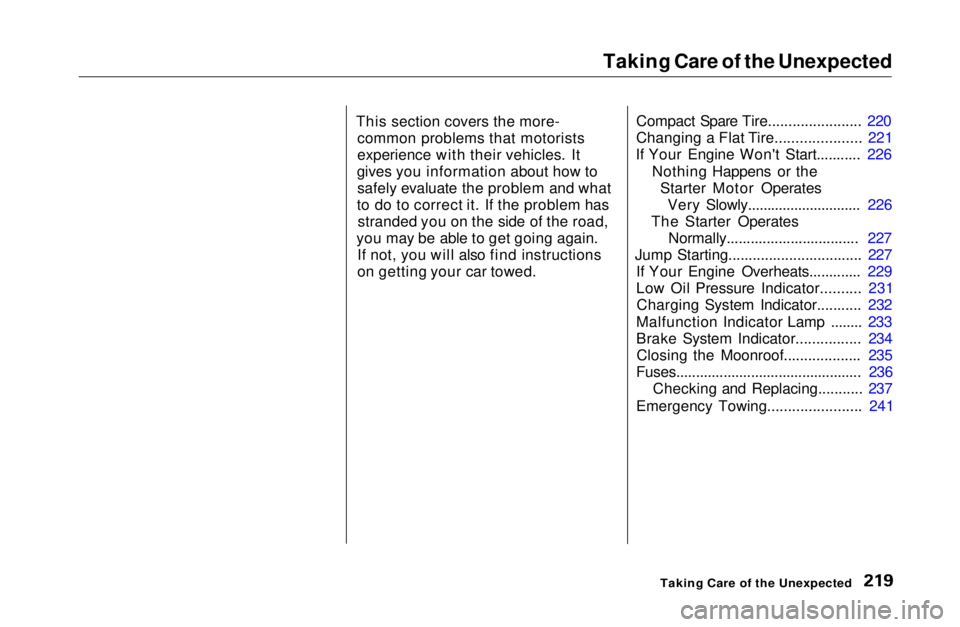
Taking Care of the Unexpected
This section covers the more- common problems that motorists
experience with their vehicles. It
gives you information about how to safely evaluate the problem and what
to do to correct it. If the problem has stranded you on the side of the road,
you may be able to get going again. If not, you will also find instructions
on getting your car towed. Compact Spare Tire....................... 220
Changing a Flat Tire..................... 221
If Your Engine Won't Start........... 226
Nothing Happens or theStarter Motor OperatesVery Slowly............................. 226
The Starter Operates Normally................................. 227
Jump Starting................................. 227 If Your Engine Overheats............. 229
Low Oil Pressure Indicator.......... 231Charging System Indicator........... 232
Malfunction Indicator Lamp ........ 233
Brake System Indicator................ 234 Closing the Moonroof................... 235
Fuses............................................... 236 Checking and Replacing........... 237
Emergency Towing....................... 241
Taking Care of the UnexpectedMain Menu s t
Page 219 of 269
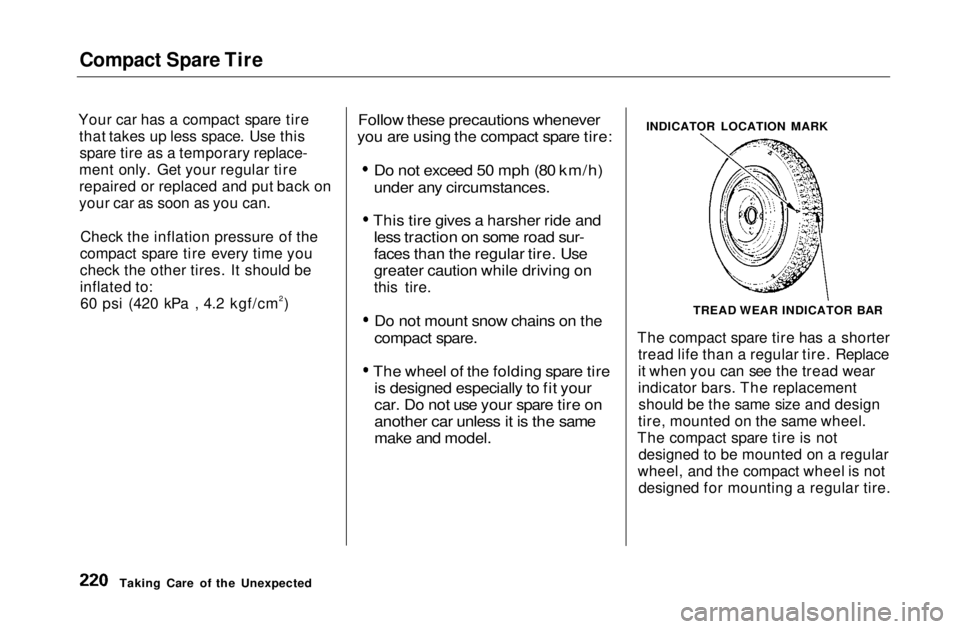
Compact Spare Tire
Your car has a compact spare tire that takes up less space. Use thisspare tire as a temporary replace-
ment only. Get your regular tire
repaired or replaced and put back on
your car as soon as you can.
Check the inflation pressure of the
compact spare tire every time you
check the other tires. It should be
inflated to: 60 psi (420 kPa , 4.2 kgf/cm2)
Follow these precautions whenever
you are using the compact spare tire:
Do not exceed 50 mph (80 km/h)
under any circumstances.
This tire gives a harsher ride and
less traction on some road sur-
faces than the regular tire. Use
greater caution while driving on
this tire.
Do not mount snow chains on the
compact spare.
The wheel of the folding spare tire is designed especially to fit your
car. Do not use your spare tire on
another car unless it is the same
make and model.
The compact spare tire has a shorter
tread life than a regular tire. Replace
it when you can see the tread wear
indicator bars. The replacementshould be the same size and design
tire, mounted on the same wheel.
The compact spare tire is not designed to be mounted on a regular
wheel, and the compact wheel is not designed for mounting a regular tire.
Taking Care of the Unexpected INDICATOR LOCATION MARK
TREAD WEAR INDICATOR BARMain Menu Table of Contents s t
Page 220 of 269
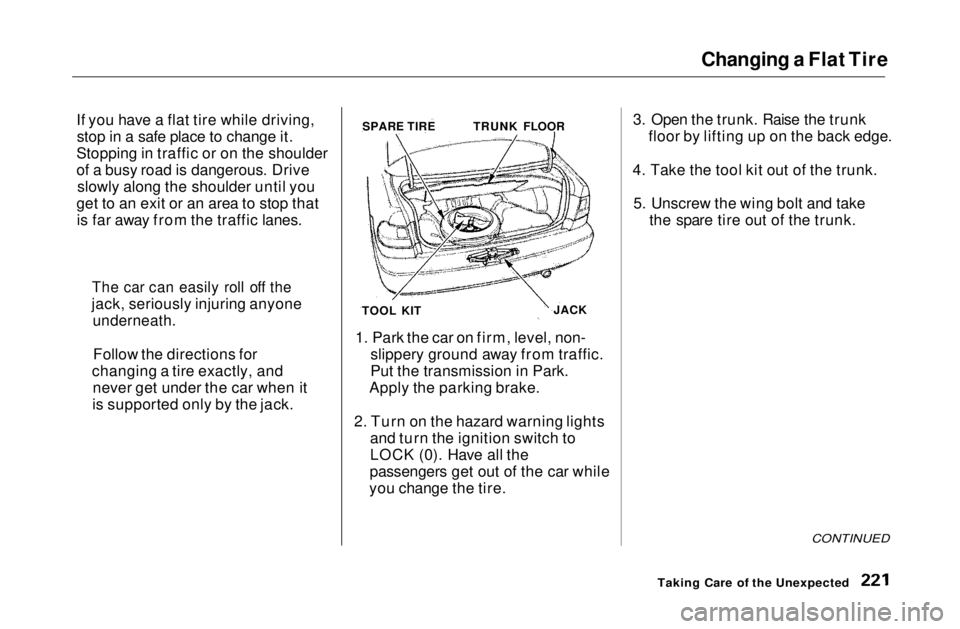
Changing a Flat Tire
If you have a flat tire while driving, stop in a safe place to change it.
Stopping in traffic or on the shoulder
of a busy road is dangerous. Drive slowly along the shoulder until you
get to an exit or an area to stop that is far away from the traffic lanes.
1. Park the car on firm, level, non-slippery ground away from traffic.
Put the transmission in Park.
Apply the parking brake.
2. Turn on the hazard warning lights and turn the ignition switch to
LOCK (0). Have all the
passengers get out of the car while
you change the tire. 3. Open the trunk. Raise the trunk
floor by lifting up on the back edge.
4. Take the tool kit out of the trunk. 5. Unscrew the wing bolt and take the spare tire out of the trunk.
CONTINUED
Taking Care of the Unexpected
SPARE TIRE
TRUNK FLOOR
JACK
TOOL KIT
The car can easily roll off the
jack, seriously injuring anyone
underneath.
Follow the directions for
changing a tire exactly, and never get under the car when it
is supported only by the jack.Main Menu Table of Contents s t
Page 222 of 269
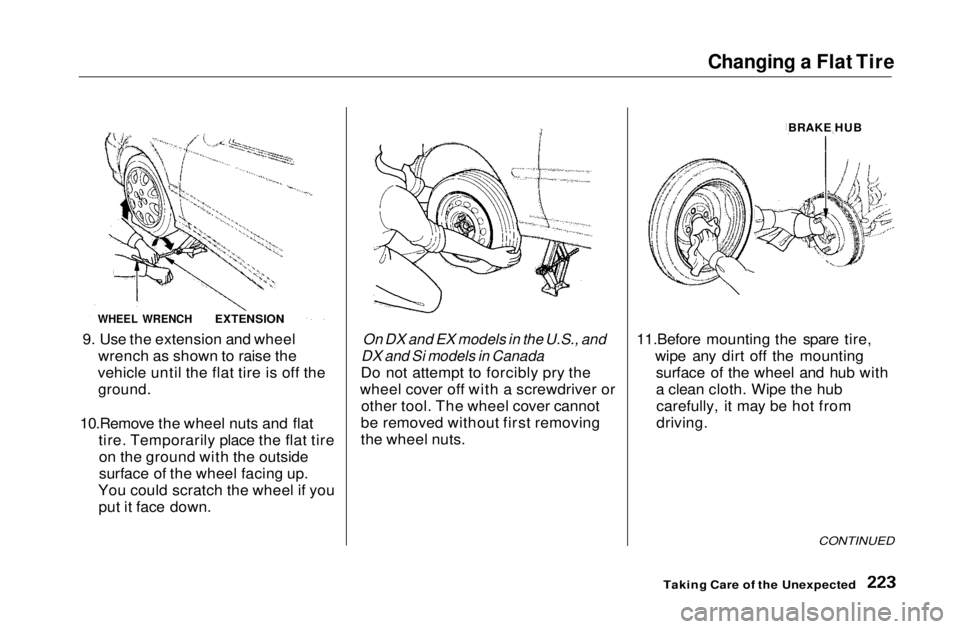
Changing a Flat Tire
9. Use the extension and wheel wrench as shown to raise the
vehicle until the flat tire is off the
ground.
10.Remove the wheel nuts and flat tire. Temporarily place the flat tireon the ground with the outside
surface of the wheel facing up.
You could scratch the wheel if you put it face down.
On DX and EX models in the U.S., and
DX and Si models in Canada
Do not attempt to forcibly pry the
wheel cover off with a screwdriver or other tool. The wheel cover cannot
be removed without first removing
the wheel nuts. 11.Before mounting the spare tire,
wipe any dirt off the mountingsurface of the wheel and hub with
a clean cloth. Wipe the hubcarefully, it may be hot from
driving.
CONTINUED
Taking Care of the Unexpected
WHEEL WRENCH EXTENSION
BRAKE HU BMain Menu Table of Contents s t
Page 223 of 269

Changing a Flat Tire
12.Put on the spare tire. Put the wheel nuts back on finger-tight,then tighten them in a crisscross
pattern with the wheel wrench
until the wheel is firmly against
the hub. Do not try to tighten
them fully.
13.Lower the car to the ground and
remove the jack.
14.Tighten the wheel nuts securely in
the same crisscross pattern. Have
the wheel nut torque checked at
the nearest automotive service
facility.
Tighten the wheel nuts to: 80 lbf.ft (108 N.m,11 kgf.m)
Taking Care of the UnexpectedMain Menu Table of Contents s t
Page 261 of 269

Index
Before Driving............................... 123
Belts, Seat........................................... 8
Beverage Holder.............................. 84
Body Repair.................................... 214
Brakes Anti-lock System (ABS)............ 151Break-in, New Linings .............. 124
Fluid............................................ 182
Light, Burned-out...................... 206
Parking.......................................... 82
System Indicator.......................... 55
Wear Indicators......................... 150
Brakes, ABS Operation.................................... 150
System Indicator................. 55, 153
Braking System.............................. 150
Break-in, New Car......................... 124
Brightness Control, Instruments... 62
Brights, Headlights......................... 61
Bulb Replacement Back-up Lights........................... 207
Brake Lights ...................... 206, 207
Front Parking Lights................. 205
Front Side Marker Lights......... 205
Headlights.................................. 204
High-mount Brake Light.......... 209
Interior Light.............................. 210
License Plate Lights.................. 209
Rear Side Marker Lights.......... 206
Specifications............................. 248
Trunk Light................................ 211
Turn Signal Lights............. 205, 206
Bulbs, Halogen............................... 204
Cables, Jump Starting With.......... 227
Capacities Chart............................. 247
Carbon Monoxide Hazard.............. 49
Carrying Cargo.............................. 132
Cassette Player
Operation.................................... 115
CAUTION, Explanation of............... ii
CD Changer.................................... 100
CD Player........................................ 100
Certification Label......................... 244
Chains............................................. 201
Change Oil
How to......................................... 173
When to....................................... 162
Changing a Flat Tire..................... 221
Changing Engine Coolant............. 177 Charging System Indicator.... 55, 232
Checking
Automatic Transmission
Fluid........................................ 180
Battery Condition...................... 189
Brake Fluid................................. 183
Clutch Fluid................................ 183
Drive Belts.................................. 194
Engine Coolant........................... 128
Engine Oil................................... 127
Fuses........................................... 236
Manual Transmission Fluid ..... 182
Power Steering Fluid................. 184
Checklist, Before Driving............. 136
Cleaner, Air.................................... 185
Cleaning Exterior....................................... 214
Interior........................................ 216 Seat Belts.................................... 216
Vinyl............................................ 216 Windows..................................... 217
Clock, Setting the ............................ 99
Clutch Fluid.................................... 183
CO in the Exhaust......................... 254
Cold Weather, Starting in............. 137
Compact Spare............................... 220Main Menu s t